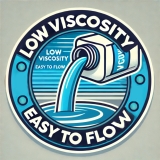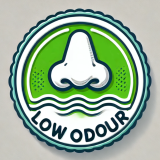




Kit consists of 10kg of PART A and 10kg of PART B
Total kit volume 18.5 Litres
PART A and PART B are both clear liquids which are odourless and non-toxic. The two components mix easily with a simple 1:1 ratio and because of the low viscosity can be used without a vacuum chamber. They react to form a translucent beige/off white coloured flexible, elastic material with high tensional and tear strength.
There is practically no shrinkage (0.1%) and excellent reproduction of fine detail. Being an addition/platinum cured rubber its chemical and heat resistance (250°C) properties are superior to tin/condensation cure rubbers translating into a longer mould life.
The pot life is approximately 8-12 minutes and the cure time is 1-2 hours for the medium and soft versions. The extra soft version has a pot life of 10-20 minutes with a cure time of 2-4 hours
Available in three hardnesses, extra soft, soft and medium. The soft is better suited to moulding delicate, fragile items where the rubber needs to be soft and flexible enough to peel off without damaging the casting. The medium is suitable for the majority of cases.
This product is not suitable for use with food. For a suitable product please click here
It may cause skin irritation making this product unsuitable for applying directly to human skin for life casting. For a suitable product please click here
The maximum operating temperature is 250°C. For a high temperature rubber click here
For creating a two part mould or moulding a glass object a release agent is required click here
Can be pigmented to a wide range of colours click here
It can be softened to your own requirements using this softening additive click here
Can be made thixotropic for applying to vertical surfaces or to over head objects click here
| Properties | Units | Extra Soft | Soft | Medium |
|---|
| Pot Life (25°C) | Minutes | 10-20 | 8-12 | 8-12 |
| Cure Time (25°C) | Hours | 2-4 | 1-2 | 1-2 |
| Viscosity (25°C) | Mpa.s | 3000 | 5000 | 8000 |
| Density (25°C) | g/cm3 | 1.08 | 1.08 | 1.08 |
| Hardness | Shore A | 5 | 15 | 28 |
| Linear Shrinkage | % | 0.1 | 0.1 | 0.1 |
| Tear Strength | KN/m | 13 | 24 | 24 |
| Elongation at Break | % | 500 | 500 | 450 |
| Tensile Strength | Mpa | 2.8 | 5.5 | 6.8 |
THE FINISHED MOULD IS SUITABLE FOR USE WITH:
Polyurethane resin
Epoxy resin *
(* Excl. some epoxies, check with supplier of the resin if silicone moulds are suitable.)
Polyester resin
Acrylic resin
Plastisol (PVC)
Plaster
Cement
Polymer clays (Will inhibit the cure of liquid platinum silicone, see below)
Waxes
Soaps
Metals with a pouring temperature below 250°C
*CURE INHIBITION*
A release agent will not create a sufficient barrier to prevent cure inhibition but a layer of paint will. If the paint is solvent based allow sufficient time for the solvent to completely evaporate off as that too can inhibit the cure
Great care must be taken when handling and mixing all addition-cured silicone elastomer systems. All the mixing tools (vessels and spatulas) should be clean and constructed in materials which do not interfere with the curing mechanism. The cure of the rubber can be inhibited by the presence of compounds of nitrogen, sulphur, phosphorus and arsenic; organotin catalysts and PVC stabilisers; epoxy resin catalysts and even contact with materials containing these substances e.g. moulding clays, sulphur vulcanised rubbers, condensation cure silicone rubbers, some printed plastics, onion and garlic.
 Technical Data Sheet
Technical Data Sheet  Safety Data Sheet Part A
Safety Data Sheet Part A  Safety Data Sheet Part B
Safety Data Sheet Part B